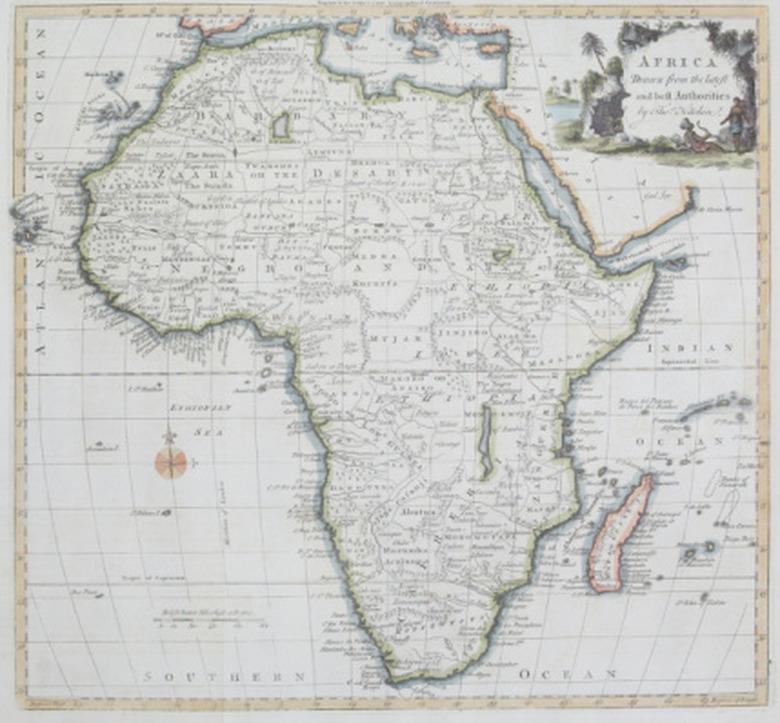Facts About The African Plate
Approximately 250 million years ago, one massive landmass existed on Earth. This supercontinent is called Pangaea, and a sole ocean called Panthalassa surrounded it. This huge landmass of crust moved over Earth's mantle, which is made of molten rock.
Eventually, the radioactivity of the mantle, with its heating and cooling cycles, caused the giant continent of Pangaea to break apart. This led to the development of major tectonic plates and eventually other minor plates. As the plates moved apart, water filling the space between them made new oceans.
TL;DR (Too Long; Didn't Read)
The African Plate is one of the major tectonic plates on Earth, and is a dynamic place of earthquakes, rifts and even counterclockwise splitting. The African Plate dives beneath the Eurasian plate, creating faults and earthquakes along its boundary. The African Plate is undergoing a split in the East African Rift Valley, and Africa will likely split into separate continents in the future.
Major Tectonic Plates
Major Tectonic Plates
Tectonic plates are gigantic pieces of the Earth's crust, or lithosphere, which join together at plate boundaries. There are about 20 tectonic plates. One of these major tectonic plates is the African Plate. Other examples include the Eurasian Plate, the Arabian Plate, the North American Plate and the South American Plate, among others.
They almost fit like a puzzle, and when viewed from space, South America and Africa look as though they could fit together. When Pangaea existed, that was indeed the case. The dynamic tectonic shift led these landmasses to separate.
Types of Plate Boundaries and Features
Types of Plate Boundaries and Features
There are a number of types of plate boundaries and features of tectonic plates. Some of the features include rifts and ridges. Plate boundaries include convergent, divergent and transform plate boundaries. These are changeable areas of the Earth's crust that create earthquakes and form volcanoes, where the magma from inside Earth can spill onto the crust from plate intersections.
Convergent plate boundaries occur where the Earth's tectonic plates collide with each other. At convergent plate boundaries, mountain-building often occurs. This is the kind of plate boundary that formed the lofty Himalayas. Alternatively, plates might dive under each other in what is called subduction. This process can form ocean trenches. Subduction leads to some of the world's strongest earthquakes.
Divergent plate boundaries are types of boundaries that occur when tectonic plates spread apart. Mountain chains called ridges often develop at divergent plate boundaries. Beneath the ocean, the Mid-Atlantic Ridge developed where major plates spread: North American/Eurasian Plates and South American/African Plates.
Transform plate boundaries occur when tectonic plates drift past each other horizontally. The San Andreas Fault is an example of a transform plate boundary. This shifting and sliding results in considerable seismic activity in the form of earthquakes.
The African Plate
The African Plate
One plate that has undergone and continues to experience much dynamism is the African Plate. Many countries sit atop the African Plate, and the plate boundaries experience significant seismic activity that affects those who reside there. These boundaries have also created highly diverse environments, especially in the rifts and ridges of the African Plate.
The African Plate dives beneath the Eurasian Plate. This boundary happens to exist beneath Italy. In the Apennine Mountains, this led to many faults developing, the movement of which has led to devastating earthquakes over time.
The African Plate is currently being stretched in certain places, leading to splitting. In Northern Ethiopia, there is a Y-shaped rift. Another region of activity is where the African Plate diverges from the Arabian Plate. This formed the Red Sea and the Gulf of Aden. Along the East African Rift Valley, the African plate is splitting into two plates called the Nubian and Somalian Plates.
Rifts and Ridges: African Plate Dynamics
Rifts and Ridges: African Plate Dynamics
Rift valleys comprise the lower areas where tectonic plate boundaries move apart, and tend to be long and narrow. This occurs both on the Earth's surface and on the bottom of the oceans. The most well-known rift on our planet is the Great Rift Valley System, comprised of the Jordan Rift Valley to the north and the East African Rift Valley in the south. The Jordan Rift Valley is where the African Plate has spread away from the Arabian Plate. The East African Rift is where Africa has begun to split. Rift Valleys can flood to form rift lakes.
Where the Nubian and Somalian plates separate from the African Plate, the East African Rift Valley has emerged within the past 25 million years. This immense split stretches about 3,500 kilometers. Its eastern portion experiences much volcanic activity, and the western portion houses numerous lakes with deep earthquakes. While the East African Rift Valley resides above sea level now, eventually it is likely to continue to diverge, allowing in seawater and creating a new ocean.
A microplate called the Victoria Plate is a portion of the East African Rift System that is currently shifting in a counterclockwise direction, diverging from other microplates to its south. Scientists think that this movement is related to the differences in strength along the earth's crust, rather than the mantle's activity beneath. More research is needed into this recent example of how Earth remains a dynamic, constantly changing world, and how those changes will affect life.
References
- The Guardian: The Geology That Causes Italy's Spine to Quake
- The Geological Society – Plate Tectonic Stories: East African Rift Valley, East Africa
- Newsweek: One of Africa's Tectonic Plates Is Rotating in a Different Direction to All the Others
- National Geographic: Plate Boundaries
- National Geographic: Rift Valley
- National Ocean Service: What Is Tectonic Shift?
Cite This Article
MLA
Hermance, Dianne. "Facts About The African Plate" sciencing.com, https://www.sciencing.com/african-plate-8667337/. 2 November 2021.
APA
Hermance, Dianne. (2021, November 2). Facts About The African Plate. sciencing.com. Retrieved from https://www.sciencing.com/african-plate-8667337/
Chicago
Hermance, Dianne. Facts About The African Plate last modified March 24, 2022. https://www.sciencing.com/african-plate-8667337/
